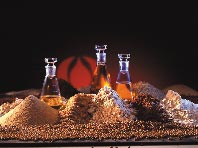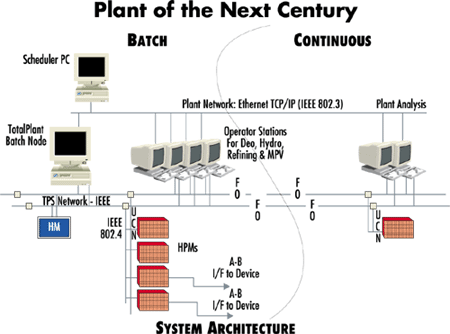
A large share of the Y2K process control project, which was begun in August 1998, involved unifying the controls for both continuous plant and batch processing areas and sharing collected data. The project also included an upgrade of the existing lab facilities and the installation of a new Local Area Network (LAN) with fiber optic backbone throughout the site.
At the Channahon facility, crude vegetable oil is processed into varying grades of fat or oil and then reblended to achieve the cooling curves and melting points specified by food manufacturers. The fats are commonly used as coatings to preserve dried fruit or, with the addition of emulsifiers, to improve texture and extend the shelf life of bread and bakery products.
Production at the Channahon facility is broken down into interchangeable batch and continuous processes, with operations including solvent fractionation, dry fractionation, hydrogenation and deodorization. Prior to the control system upgrade, the facility relied on two separate, isolated systems to control the continuous and batch plants. However, the continuous control system could not be upgraded for Y2K compliance. The batch system provided a migration path for new technology, but could not be integrated with the existing continuous system or other company facilities.
"Best Practices"
Faced with an aggressive 11-month schedule for Y2K compliance and the need to implement newer control technology, plant management looked to other Loders-Croklaan facilities for examples of best practices. One of the plants, located in Wormerveer, Netherlands, had built on its existing distributed control technology to optimize its automation capabilities and achieve Y2K readiness. The plant installed a distributed control system (DCS) for boilerhouse control in the early 1970s, and periodically added to the system until it encompassed major processing operations.The flexibility of DCS enabled batch and continuous operations at Wormer-veer to be combined under a common control architecture, and allowed the facility to integrate its database and automation capability from raw materials receipt to final product delivery. Further, it allowed operators to deploy new application nodes for advanced batch control and process optimization, and could be made Y2K-ready through a simple software upgrade.
Loders-Croklaan elected to take a similar approach at the Channahon plant. The company initiated the project in October 1998, working closely with automation vendor Honeywell, Inc., to identify key objectives and establish deadlines. A major objective was to unify the plant's batch and continuous processes on one system platform. Another was the centralization of the control scheme to provide operators with an expanded view of all areas of the plant. An integrated data management capability was also needed to support online production scheduling and reporting, and to ensure connectivity to the process control system and other departments.

Windows-based solution
Working with Honeywell, Loders-Croklaan began installation of a new, Windows NT-based control solution in December 1998. In addition, the company installed a new Local Area Network (LAN), completed a plant-wide fiber optic installation, rebuilt the facility's office building and replaced numerous pieces of production equipment.An integrated solution for automating both batch and continuous plant areas, the system consists of high-performance process managers, a graphical Human/ Machine Interface (HMI), and advanced application nodes for automating batch processes and collecting and storing control data. The system supports a vast array of database interfaces.
Four process managers, with PC-based operator workstations, are used to control the batch processes. The system also employs batch automation software and a history module. The batch operations involve tank switching, temperature control and other complex processes with more than 2,500 I/O points. An additional process manager, two operator workstations, and a history module are employed on the continuous side of production.
The redundant process managers can support up to 800 processing units each, with a processing unit being equivalent to one control loop per second. They provide all sequential, regulatory, device and logic control functions, and support the system's I/O capability. Batch phase logic executes in this control domain and communicates with the batch application through an OPC (OLE for process controls)-based communications link. Although supervised by the batch automation software, the controller operates independently.
Consistent with SP88 and IEC standards, the batch automation software provides a comprehensive solution for batch production management by supporting equipment modeling, recipe management and batch execution, and by allowing engineers to create batch control sequences that run in the process managers. It also addresses mode and state propagation, exception handling, reporting, and unit arbitration, and allows for class-based or equipment-independent recipes. The software includes a graphical phase builder tool that simplifies the implementation and maintenance of batch control logic by providing online and design views in the same format, as well as the implementation of communications rules used between units, equipment modules and control modules.
History module
The history module functions as a historian and real-time database for the process control system. Plant personnel can access the system data for supervision and regulatory reporting.With the new HMI environment, operators have a single location for operational control, as well as access to process and business data across the enterprise. The HMI's display environment, which can be configured for specific operational scenarios, enables operators to maintain their view of process and alarm status while accessing and viewing other data. The information is presented without interfering with normal process control operations (i.e. process displays versus auxiliary displays).
As part of the controls modernization, plant managers worked with Honeywell to deploy a new, online production scheduler. Built on a customized Microsoft Access database, the scheduler automates the entire scheduling for a key batch process -- the critical element in improving responsiveness to customers' on-demand product requirements. The scheduling module, which interfaces with the batch application and other process equipment, assists operators in coordinating the appropriate recipes for a given production requirement. Further, it allows planners to view online production operations and review schedule status from remote locations.
Honeywell Industrial Automation & Control, 16404 N. Black Canyon Hwy., Phoenix, AZ 85053-3033. Tel. (602) 313-5000; fax (602) 313-5692; www.iac.honeywell.com
